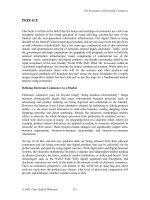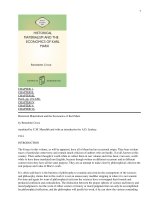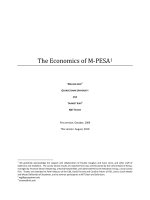giáo trình the economics of electronic commerce
Bạn đang xem bản rút gọn của tài liệu. Xem và tải ngay bản đầy đủ của tài liệu tại đây (5.59 MB, 572 trang )
To access the contents, click the chapter and section titles.
Economics of Electronic Commerce
Go!
Keyword
Brief
Full
Advanced
Search
Search Tips
-----------
(Publisher: Macmillan Computer Publishing)
Author(s): Soon-yong Choi; Andrew Whinston; Dale Stahl
ISBN: 1578700140
Publication Date: 07/22/97
Search this book:
Go!
Contents
About This Book
Trademark Acknowledgments
Credits
Chapter 1 - Electronic Commerce and the Internet
Chapter 2 - Characteristics of Digital Products and Processes
Chapter 3 - Internet Infrastructure and Pricing
Chapter 4 - Quality Uncertainty and Market Efficiency
Chapter 5 - Economic Aspects of Copyright Protection
Chapter 6 - Signaling Quality and Product Information
Chapter 7 - Consumers' Search for Information
Chapter 8 - Product Choices and Discriminatory Pricing
Chapter 9 - Financial Intermediaries and Electronic Commerce
Chapter 10 - Electronic Payment Systems
Chapter 11 - Business and Policy Implications of Electronic Commerce
Chapter 12 - Future Directions for Economic Research
Products | Contact Us | About Us | Privacy | Ad Info | Home
Use of this site is subject to certain Terms & Conditions, Copyright © 1996-2000 EarthWeb Inc.
All rights reserved. Reproduction whole or in part in any form or medium without express written permission of EarthWeb is
prohibited. Read EarthWeb's privacy statement.
To access the contents, click the chapter and section titles.
Economics of Electronic Commerce
Go!
Keyword
Brief
Full
Advanced
Search
Search Tips
(Publisher: Macmillan Computer Publishing)
Author(s): Soon-yong Choi; Andrew Whinston; Dale Stahl
ISBN: 1578700140
Publication Date: 07/22/97
Search this book:
Go!
Table of Contents | Next
Page 7
-----------
Contents
Contents at a Glance
Chapter One
Electronic Commerce and the Internet 1
Chapter Two
Characteristics of Digital Products and Processes 59
Chapter Three
Internet Infrastructure and Pricing 93
Chapter Four
Quality Uncertainty and Market Efficiency 137
Chapter Five
Economic Aspects of Copyright Protection 175
Chapter Six
Signaling Quality and Product Information 213
Chapter Seven
Consumers' Search for Information 263
Chapter Eight
Product Choices and Discriminatory Pricing 313
Chapter Nine
Financial Intermediaries and Electronic Commerce 373
Chapter Ten
Electronic Payment Systems 407
Chapter Eleven
Business and Policy Implications of Electronic Commerce 463
Chapter Twelve
Future Directions for Economic Research 539
Index 583
Page 8
Page 9
Table of Contents
1 Electronic Commerce and the Internet 1
1.1. Developments in Internetworking 2
Distributed and Networked Computing 3
Open Networks 5
Two-way Communications and the Web 9
1.2. Electronic Commerce 12
Electronic Commerce Examples 13
Electronic Commerce as a Communications Network 15
Electronic Commerce of Digital Products 16
Commercial Potential of the Internet 21
1.3. Market Characteristics of Electronic Commerce 22
Current Commercial Uses of the Internet 23
User Characteristics 25
Competition and Market Organization 27
Business Organization and Virtual Firms 30
Legal Environment 32
1.4. Current Issues in Electronic Commerce 35
Contents and Quality 35
Copyrights versus Users Rights 38
Copyright and the Freedom of Speech 39
Legal and Economic Considerations of Copyrights
40
Interactive Advertising and the Use of Consumer Information 41
Push or Pull Advertising 42
Measuring the Impact of Online Advertising 43
Targeted Advertising and Privacy 44
Internet Intermediaries 45
Security and Privacy of Internet Transactions 46
Page 10
Pricing Strategies for Digital Products 48
Online Taxation, Regulation, and Other Legal Issues 50
1.5. Summary 51
References 53
Suggested Readings and Notes 54
History of the Internet 54
Firms and Markets 54
Electronic Data Interchange (EDI) 55
Internet Resources 55
Implications of Digital Process 55
The Internet Society (ISOC) 56
2 Characteristics of Digital Products and Processes 59
2.1. What Are Digital Products? 60
2.2. Characteristics of Information Products 64
Dependence on Individual Preference 65
Transitory or Cumulative Utility 65
Externalities of Information Products 66
Intrinsic Values of Digital Products 69
2.3. The Physical Nature of Digital Products 69
Indestructibility 70
Transmutability 72
Reproducibility 73
Physical Nature and Economic Issues 74
Product Selection Strategies Based on the Taxonomy 84
Changing Time Dependence 85
Changing Usage Patterns 85
Transfer Mode and Externalities 86
2.4. Summary 87
References 89
Page 11
Suggested Readings and Notes 89
Value of Information 89
Electronic Markets 90
Network Externalities 90
Internet Resources 91
Java Programming Language 91
Commercial Sites Index 91
Virtual Museums and Florist 91
Medical Sites on the Internet 92
3 Internet Infrastructure and Pricing 93
3.1. Internet Pipelines 93
3.2. Traffic Control on the Internet 96
Packet Switching 96
Internet Protocol Addresses 97
Transmission Control Protocol 100
Unicast, Broadcast, and Multicast 100
3.3. The Infrastructure Convergence 103
The Convergence in the Last Mile 104
Long-Haul Traffic 107
3.4. Congestion and Infrastructure Pricing 109
Ideal Economic Pricing Proposals 112
Dynamic Optimal Pricing 114
Static Priority Pricing 117
The Smart-Market Approach 118
Connection-Only and Flat-Rate Pricing 119
Voluntary User Declarations 122
Synopsis 122
3.5. Public Policy and Infrastructure 123
Public Policy for a Publicly Owned Network 124
Public Policy for a Privately Owned Network 125
3.6. Summary 127
References 130
Page 12
Suggested Readings and Notes 133
Further Readings on Game Theory 133
Internet Resources 133
The Internet Networking Infrastructure 133
Domain Name Registration 134
MBONE (Multicast Backbone) 134
IETF IP Multicasting Proposals 135
Broadband Online Services 135
4 Quality Uncertainty and Market Efficiency 137
4.1. Economics of the Lemons Market 139
Price as a Signal for Quality 141
Remedies for the Lemons Problem 143
4.2. Information Channels in Electronic Commerce 145
Sellers Provide Product Information 145
Freeware, Shareware, and Other Promotions 148
Free Products Online 148
The Economics of Try-Outs 150
Third-Party Information 152
Retailers and Other Brokers 153
4.3. Quality and Intermediaries 155
Transactional Efficiencies 156
Intermediaries as Experts 158
Intermediaries as an Information Source 161
Intermediaries as Producers 162
4.4. Intermediaries and Contracts 163
Subcontracting Systems 164
Incomplete Contracts 166
4.5. Summary 169
References 170
Suggested Readings and Notes 171
Economics of the Lemons Problem 171
Repeat Purchases and Reputation 172
Page 13
Internet Resources 173
Internet Commerce 173
Internet and Economics 173
5 Economic Aspects of Copyright Protection 175
5.1. Economic History of Copyright 176
The Property Aspect of Copyright 178
The Authorship Aspect of Copyright 183
Public Interest 184
5.2. The Nuts and Bolts of Copyrights 186
Objects Covered by Copyright 186
Terms of Copyright 187
Works That Cannot Be Copyrighted 187
Specific Rights of Authors Granted by Copyright 189
Fair Use Doctrine 190
Other Intellectual Property Laws 191
5.3. Copyright Protection and Digital Products 192
Reproduction 192
Reproductions on the Internet 193
Economic Implications of Reproduction 195
Resale and Distribution 195
Resale and the First Sale Doctrine 196
Resale Prevention and Pricing 198
Content Control 200
5.4. Market Protection Through Business Strategies 202
5.5. Policy Implications 204
Copyright and Antitrust Concerns 205
5.6. Summary 207
References 209
Suggested Readings and Notes 210
Historical Development of Copyright Laws 210
Patents and Economics 211
Page 14
Internet Resources 211
Articles 211
Internet Copyright Sites 212
Texts of Copyright Laws 212
World Intellectual Property Organization (WIPO)
Conference Resources 212
6 Signaling Quality and Product Information 213
6.1. Advertising on the Internet 214
Growth in Electronic Advertising 215
Types of Internet Advertising 217
Banner Ads 218
Selling Advertising to Consumers 220
Web Storefronts 222
6.2. The Economics of Advertising 223
The Economic Roles of Advertising 224
The Informational Content of Advertising 231
Information about Information Products 231
The Effect of Advertising on Price 234
Advertising and Product Differentiation 237
6.3. Other Strategies to Convey Product Information 239
Repeat Purchases and Reputation 239
Reputation Building in Electronic Commerce 240
Renting a Reputation 241
Shareware and Wasted Investments 242
Quality Guarantees for Digital Products 243
6.4. Marketing Strategies for the Internet 244
Myths and Popular Wisdom about Online Advertising 245
Broadcast versus Targeted Advertising 246
Push versus Pull Advertising 249
Advertisements as Commodities 251
Passive versus Active Marketing 252
Electronic Malls and Intermediaries 253
Page 15
Is Online Advertising Effective? 254
Providing Consumer Information 256
6.5. Summary 257
References 258
Suggested Readings and Notes 260
Advertising and Competition 260
Signaling 260
Internet Resources 261
Web Directory for Advertising 261
Popular Wisdom on Internet Marketing 261
Shareware Resources 262
7 Consumers' Search for Information 263
7.1. Consumer Searches and Economic Efficiency 263
Search Costs 265
Consumer Searches and Electronic Commerce 267
Digital Products and Consumer Searches 269
7.2. The Search Market and Intermediaries 270
Search Market Efficiency 271
Search Efficiency in Intermediaries 276
Search Efficiency in Informational Content 278
7.3. Search Engines on the Internet 280
Search or Surf? 281
Inadequacies of Search Engines 281
7.4. Market Efficiency In Various Information Sources 282
The World Wide Web 283
Web Searches 284
Gopher 285
Gopher Search 285
Anonymous FTP and Telnet 286
FTP Search by Archie 287
UseNet 287
Page 16
Mailing Lists 289
Electronic Messaging 290
E-mail Address Search 292
Consumer Learning and Search 292
7.5. Information Efficiency in Web Search Engines 294
Information Acquisition and Efficiency 298
Advertising versus Consumer Searching 305
7.6. Summary 307
References 309
Suggested Readings and Notes 309
Consumer Search 309
Internet Resources 310
Search Engines 310
Software Agents and Filtering 311
Robomoderation 311
8 Product Choices and Discriminatory Pricing 313
8.1. Product Differentiation and Pricing in Economics 315
What Is Product Differentiation? 315
Horizontal Differentiation 316
Vertical Differentiation 317
The Incentive to Differentiate 318
Chamberlinian Monopolistic Competition 319
Price Discrimination 320
Variations in Consumption Values: A Simple Case of
Price Discrimination 322
Product Matching 323
8.2. Product Customization 325
Sellers' Use of Transmutability 325
Gains and Losses from Customization 328
Consumer Arbitrage 328
Reduced Waste 329
Page 17
Price Discrimination 329
8.3. Use of Consumer Information 331
Primary and Secondary Consumer Information 331
Privacy and Anonymity 337
Anonymity as a Myth 337
Legal Efforts to Protect Privacy 340
Market-Based Solution to Protect Personal
Information 341
Consumer Information and Discriminatory Pricing 344
8.4. Pricing Digital Products 347
Cost Curves 348
Standard U-Shaped Average Cost Curve 348
Average Cost Curve of a Digital Product 349
Strategic Factors in Pricing 352
Quality Choices 352
Product Differentiation 355
Incentive Compatible Prices 356
Selling versus Renting Digital Products 359
Subscription and Bundling 361
The Case for Microbundles and Micropayments 365
8.5. Summary 367
References 368
Suggested Readings and Notes 369
Nonlinear Pricing 369
Product Differentiation 370
Price Discrimination 370
Internet Resources 371
Customized Internet Products 371
Privacy on the Internet 371
Cookies 372
Spoofing on the Internet 372
9 Financial Intermediaries and Electronic Commerce 373
9.1. Types of Financial Intermediaries 375
Page 18
9.2. Transactional Efficiencies 378
Phases of Transaction 379
Efficiency in Search Process 379
Negotiation and Settlement Processes 381
Financial Intermediaries: Electronic Market Case Studies 382
Internet Initial Public Offerings 383
Digital Exchange Markets 385
9.3. Transformation Functions 388
Maturity Transformation 389
Volume Transformation 389
Electronic Commerce Effects 390
9.4. Information Brokerage 390
Information Uncertainty and Risk 390
Information Trading 391
Certification and Assurance 394
9.5. Summary 399
References 401
Suggested Readings and Notes 402
Financial Intermediation and Credit Rationing 402
Internet Resources 403
Electronic Banking Resource Center 403
Encryption Technologies 403
Financial Services on the Internet 404
Digital Signature and Certification Services 404
10 Electronic Payment Systems 407
10.1 Electronic Payment Systems: An Overview 407
Payment Patterns 408
Types of Electronic Payment Systems 410
Conventional Payment Process 411
10.2. Payment Clearing Services 417
10.3. Notational Funds Transfer 421
Page 19
10.4. Digital Currency Payment Systems 426
Money as a Medium of Exchange 427
Inside Money and Outside Money 428
Needs for Electronic Currency Payment Systems 430
Anonymity in Transactions 430
Micropayments and the Internet 430
The Transferability of Value 431
10.5. Properties and Specifications of Digital
Currencies 432
Desirable Properties of Digital Currency 432
Monetary Value 432
Convenience 433
Security 433
Authentication 434
Non-Refutability 434
Accessibility and Reliability 434
Anonymity 435
Technical Specifications of Digital Currencies 435
Ecash 436
Millicent 438
Mondex 439
10.6. Evaluation and Policy Issues 440
Information Contents of Transactions 440
Transactional Efficiency 442
Monetary Effects 443
Effects on Market Organization 449
10.7. Digital Currency and Governments 451
Effects on Government Revenues 452
Regulatory Issues 453
Issues in International Commerce 455
10.8. Summary 457
References 459
Page 20
Suggested Readings and Notes 460
Quantity Theory of Money 460
Monetary Freedom 460
Electronic Payment Systems 461
Internet Resources 462
Electronic Money Resources 462
Standard Electronic Transactions (SET) 462
11 Business and Policy Implications of Electronic Commerce 463
11.1. Internet as the Great Equalizer 464
The Virtual Equality 464
The Reputational Transfer 465
Declining Average Costs and the Advantage of Size 466
Product Differentiation and Size 467
11.2. Search Service and Its Market Implications 468
Advertising in Broadcast Media 469
Search Engines and Advertising 471
Digital Cataloging Guidelines 472
Content Description 472
Search Interfaces 473
11.3. Copyright Protection Standards 474
11.4. The Use of Consumer Information 475
11.5. Digital Products and Pricing 477
Bundling and Subscription 477
Unbundling and Micropayments 482
Micropayments and Product Quality 483
Information Products and Economics 487
11.6. Taxation and the Future of Electronic Commerce 489
Taxable Item 489
Taxes on Access 490
Taxes on Transactions 492
Sales versus Transfer of Copyrights 496
Page 21
11.7. Anonymity and Legal Environment for Commerce 497
11.8. Global Framework for Electronic Commerce 501
Convergence in Spatial Markets 502
Artificial Borders 503
Uniform Commercial Environment 505
11.9. Antitrust and Regulation Policies 510
Economies of Scale and Regulation 511
Interoperability, Standardization, and Market Dominance 513
Network Externality and Monopolization 516
Monopoly and Welfare Loss: The Problem 516
Externalities and Their Effects 520
Network Effects versus Network Externalities 522
Anticompetitive Behaviors 523
Common Carriers and Microsoft 524
Vertical Integration and Retail Wheeling 525
11.10. The Economics of Electronic Commerce and the Internet 528
The Economics of Electronic Commerce 529
The Economics of Information Infrastructure 531
11.11. Summary 533
References 534
Suggested Readings and Notes 536
Law for the Internet 536
Internet Resources 536
Online Commerce and Taxation 536
Laws Regarding Computers 536
Internet Telephony 537
12 Future Directions for Economic Research 539
Page 22
12.1. The Role of Enabling Technologies 543
12.2. The Virtual World is Built on the Physical World 547
12.3. Components of the Virtual Economy 551
12.4. The Convergence 553
Convergence and the Market Structure 556
12.5. The Virtual Economy in Action 558
12.6. Growth of Virtual Intermediaries 563
12.7. Customization and Smart Products 566
Producer's Customization and Market Research 566
Online Market Research 568
Online Learning 569
Consumer Customization 571
12.8. Globalization and Cybernations 573
12.9. Market-Clearing Mechanisms 576
12.10. Summary 578
References 580
Internet Resources 581
Smart Products 581
Habitat and Virtual Communities 581
The 21st Century Technologies 581
Index 583
Table of Contents | Next
Products | Contact Us | About Us | Privacy | Ad Info | Home
Use of this site is subject to certain Terms & Conditions, Copyright © 1996-2000 EarthWeb Inc.
All rights reserved. Reproduction whole or in part in any form or medium without express written permission of EarthWeb is
prohibited. Read EarthWeb's privacy statement.
To access the contents, click the chapter and section titles.
Economics of Electronic Commerce
Go!
Keyword
Brief
Full
Advanced
Search
Search Tips
(Publisher: Macmillan Computer Publishing)
Author(s): Soon-yong Choi; Andrew Whinston; Dale Stahl
ISBN: 1578700140
Publication Date: 07/22/97
Search this book:
Go!
Previous | Table of Contents | Next
Page 1
-----------
About this book
The Economics
of Electronic Commerce
Soon-Yong Choi
Dale O. Stahl
Andrew B. Whinston
Macmillan Technical Publishing, Indianapolis, Indiana
Page 2
The Economics of Electronic Commerce
By Soon-Yong Choi, Dale O. Stahl, and Andrew B. Whinston
Published by:
Macmillan Technical Publishing
201 West 103rd Street
Indianapolis, IN 46290 USA
All rights reserved. No part of this book may be reproduced or transmitted in
any form or by any means, electronic or mechanical, including photocopying,
recording, or by any information storage and retrieval system, without written
permission from the publisher, except for the inclusion of brief quotations in a
review.
Copyright " 1997 by Macmillan Technical Publishing
Printed in the United States of America 1 2 3 4 5 6 7 8 9 0
Library of Congress Cataloging-in-Publication Number 96-80466
ISBN 1-57870-014-0
Warning and Disclaimer
This book is designed to provide information about the Internet. Every effort
has been made to make this book as complete and as accurate as possible, but
no warranty or fitness is implied.
The information is provided on an "as is" basis. The authors and Macmillan
Technical Publishing shall have neither liability nor responsibility to any
person or entity with respect to any loss or damages arising from the
information contained in this book or from the use of the discs or programs
that may accompany it.
PublisherDon Fowley
Publisher's AssistantRosemary Lewis
Publishing ManagerTom Stone
Marketing ManagerMary Foote
Managing EditorCarla Hall
PAGE 4
Trademark Acknowledgments
All terms mentioned in this book that are known to be trademarks or service
marks have been appropriately capitalized. Macmillan Technical Publishing
cannot attest to the accuracy of this information. Use of a term in this book
should not be regarded as affecting the validity of any trademark or service
mark.
Page 5
Credits
Acquisitions Editor Tom Stone
Senior Editors Sarah Kearns
Suzanne Snyder
Graphics Image Specialists
Sadie Crawford, Wil Cruz
Production Analyst Erich
Richter
Project Editor Brad Herriman
Production Team Tricia Flodder,
Aleata Howard, Malinda Kuhn,
Rowena Rappaport, Pamela
Woolf,
Copy Editors Margo Catts Keith Cline
Indexer Virginia Bess
Malinda McCain John Sleeva Sharon Wilke
Assistant Marketing Manager Gretchen
Schlesinger
Acquisitions Coordinators Amy Lewis Tim
Micheli
Cover Designer Gary Adair
Cover Production Aren Howell
Book Designer Glenn Larsen
Manufacturing Coordinator Brook Farling
Director of Production Larry Klein
Production Team Supervisors Laurie Casey
Joe Millay
Page 6
Previous | Table of Contents | Next
Products | Contact Us | About Us | Privacy | Ad Info | Home
Use of this site is subject to certain Terms & Conditions, Copyright © 1996-2000 EarthWeb Inc.
All rights reserved. Reproduction whole or in part in any form or medium without express written permission of EarthWeb is
prohibited. Read EarthWeb's privacy statement.
To access the contents, click the chapter and section titles.
Economics of Electronic Commerce
Go!
Keyword
Brief
Full
Advanced
Search
Search Tips
(Publisher: Macmillan Computer Publishing)
Author(s): Soon-yong Choi; Andrew Whinston; Dale Stahl
ISBN: 1578700140
Publication Date: 07/22/97
Search this book:
Go!
Previous | Table of Contents | Next
Page 1
-----------
CHAPTER 1
Electronic Commerce and the
Internet
Our objective in this and the next two chapters is to provide you with a
framework for understanding the economic impact of the new business
medium by defining electronic commerce and the nature of digital products.
Opinions regarding the future of the Internet and electronic commerce may
vary widely, but the general consensus is that commercial uses of the Internet
will have an immense effect on businesses, governments, and consumers. The
question is, "In exactly what areas and in what ways will they be affected?" A
shared definition of electronic commerce is the first step toward presenting the
answers.
In this chapter, we discuss the characteristics of computing environments that
have made the Internet the infrastructure for electronic commerce. Presented in
section 1.1 is an overview of how computing and networking environments
have evolved into the Internet. The objective here is to highlight differences
between the Internet and previous computing and communications
environments in order to give a clearer understanding of the importance of the
Internet as a commercial medium.
Section 1.2 reviews commercial and noncommercial uses of computing and
communication technologies, and defines what electronic commerce is within
the context of changing technologies. It will be evident that
Page 2
conventional distinctions between commercial and noncommercial uses of the
Internet are no longer valid. Section 1.3 discusses the market characteristics of
electronic commerce, pointing out the differences from traditional, physical
product markets as well as issues arising from the novice nature of electronic
commerce. Finally, in section 1.4, key issues in electronic commerce are
discussed along with a look at how economic analysis may help to resolve
many uncertainties. While these snapshots put the issues in perspective, later
chapters will deal with each in depth.
1.1.Developments in Internetworking
The Internet is a network of networks. Each network is comprised of
com-puters connected by wire or wireless mediums, such as radio signals, that
enable component computers to "talk" to each other. Once computers are
networked, files on one computer can be accessed from any other computer on
the network; messages can be exchanged, and limited resources such as
printers can be shared. Large or small, each network is owned and managed by
a company or a single group with the exception of the Internet.
The Internet is not owned or managed by any single entity, although its
component networks are independent units managed and usually paid for by
the network's owners. (Chapter 3, section 3.6, covers Internet technology and
infrastructure in detail; in this chapter, we focus on general characteristics of
the Internet as a market infrastructure.) Computers on these component
networks became a part of the larger Internet when they used the same
standard for cross-communication—the TCP/IP protocol—known as the
language of the Internet. Therefore, any computer "speaking" TCP/IP protocol
is Internet-enabled in terms of connectivity.
The Internet is clearly the largest network of computers in existence today.
There are, however, many non-Internet networks such as commercial online
services that are quite large in their own right. The sudden dominance of the
Page 3
Internet as a model mechanism for information transfers and commercial
transactions may seem accidental in view of these large networks. However,
the Internet or Internet-like networks have two overriding factors in their favor
to become a market infrastructure: distributed computing and openness.
Distributed and Networked Computing
A distributed computing environment consists of multiple sites (or computers)
that are capable of performing the same type of functions or executing a
portion of a task. This is in contrast to a mainframe computer environment in
which shared users send commands and receive results via dumb terminals
connected to the computer. In a mainframe environment, all of the computing
necessary to process a task is done at the central computer (the host), whereas
terminals are used only for inputting instructions and displaying results. The
Internet, on the other hand, is an example of distributed computing in which
host and client computers are each capable of independent computing.
The distinction between a host and a client is based on which machine (or
program) provides content and service. A client machine typically establishes
a connection to a host—known also as a server—and initiates a request for a
service, such as to download a file. A web browser, for example, is a program
that runs on a client machine, whereas an httpd, which sends out HTML files
(web pages) upon request by a browser, is a program that runs on a server.
However, this distinction between a server and a client is only arbitrary. In a
distributed computer network, each connected computer can act as either a
server or a client. This potential is not obvious to many Internet initiates who
use their computers as clients only. But the strength of a distributed computer
network such as the Internet is its connectivity that supports peer-to-peer
relationships. What this means in terms of a market is that each computer or
user connected to a peer-to-peer network is a potential provider of contents, for
instance, a seller as well as a buyer. Any personal computer connected to the
Internet is capable of hosting a web site or sending a file instead of simply
acting as a tool to visit web sites and download files. The traditional division
between corporations as content providers and consumers as buyers is still
Page 4
evident in the way some commercial online services organize their services so
that subscribers are targeted only as readers or customers. Such customers are
assumed to be "surfing" the net just like television viewers and newspaper
readers are passively consuming the contents provided by the sellers.
On the contrary, the strength of the Internet lies in the potentially interactive
environment in which consumers regard themselves also as the content
providers. The proliferation of personal homepages, which is often dismissed
as a transitory fad, indicates that the Internet users understand the power of the
medium in providing content. Nevertheless, the majority of Internet users are
assumed to remain passive. To surf the net, it may be adequate to have a
passive communication device which connects and downloads files without
the capability to act as a host. A stripped-down network computer—a
web-browsing machine with limited processing power—resembles a television
receiver, or a dumb terminal of the bygone era.
Even when consumers are not selling contents on the Internet, the medium's
interactivity enables sellers to collect information about consumers' tastes and
their preferences for product quality, price, and customer service using the
medium itself. Unlike the broadcasting media, the Internet facilitates two-way
interactions between sellers and buyers, the result of which can also be fed
seamlessly into production, marketing, transaction, and consumption
processes. In short, a network means a worldwide system of interaction,
whether for business or for communication, in which computers connected to
the network are simply points of presence.
As the conventional distinction between a seller and a buyer is lost in a
distributed network such as the Internet, transactional processes undergo a
similar transformation. A typical commercial transaction involves many agents
and processes. Each of these processes performs a specific
function—production, assembly, marketing, delivery, payment clearance,
insurance, certification, and so on, which typically occur in stages. Different
intermediaries have evolved to fulfill one or more of these functions in the
physical market. Intermediaries are now evolving to fulfill these functions in a
distributed computer network, where they may be processed simultaneously by
different
Previous | Table of Contents | Next
Products | Contact Us | About Us | Privacy | Ad Info | Home
Use of this site is subject to certain Terms & Conditions, Copyright © 1996-2000 EarthWeb Inc.
All rights reserved. Reproduction whole or in part in any form or medium without express written permission of EarthWeb is
prohibited. Read EarthWeb's privacy statement.
To access the contents, click the chapter and section titles.
Economics of Electronic Commerce
Go!
Keyword
Brief
Full
Advanced
Search
Search Tips
(Publisher: Macmillan Computer Publishing)
Author(s): Soon-yong Choi; Andrew Whinston; Dale Stahl
ISBN: 1578700140
Publication Date: 07/22/97
Search this book:
Go!
Previous | Table of Contents | Next
Page 5
-----------
agents. The scope of market activities undertaken by these agents will be
defined as the commerce on the Internet matures. However, the organization of
agents in electronic commerce will be sufficiently different from physical
markets. For example, the traditional difference between a wholesaler and a
retailer is lost in the digital marketplace because a producer only needs to
transmit one copy to an intermediary. An efficient market organization is more
likely because activities of each agent involved in a transaction, from
production to payment and consumption, may be monitored and evaluated
more efficiently, and new product strategies and pricing can be implemented
rapidly and concurrently. Such changes in market organization are the subject
matter of later chapters.
Open Networks
Distributed computing presupposes a network. Large corporations,
governments, and research organizations have maintained extremely large
networks of computers often made up of several layers. For internal
communication and computing needs, computers are typically connected in
local area networks (LANs) using physical connections such as cables. These
LANs can then be interconnected into wide area networks (WANs) via
telephone lines or satellite links. And private value-added networks (VANs)
have been in operation for over two decades to facilitate company-to-company
transactions using electronic data interchange (EDI). The disillusioning truth in
this image of an interconnecting system of cogs is that not all LANs and
WANs can communicate with each other, because of both technical and policy
choices made by network owners. VANs, in particular, are limited to paying
members and use proprietary communication standards. A need exists for a
means to bridge the gaps between the different sized cogs that will enable
them to communicate. The Internet is one such means.
The Internet is unique as a networking environment in that it is based on open
standards which enable any computer or network to connect to it using TCP/IP









